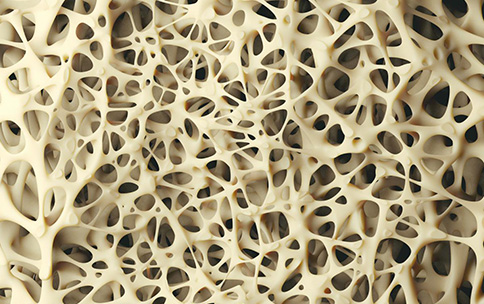
The NIH Common Fund Knockout Mouse Phenotyping Program (KOMP2) is the flagship partner of the International Mouse Phenotyping Consortium (IMPC) to knockout (remove) and characterize all protein-coding genes in the mouse genome. Overall, this project helps scientists explain the genetic basis of many different types of diseases that occur in both mice and humans, including under-studied rare diseases and common chronic conditions. This collaborative effort has been a powerful resource for describing genes with previously unknown function in hearing, vision, and metabolism, for example. Now, KOMP2 researchers gained insights into the genetics of bone diseases and conditions. Osteoporosis is characterized by increased chance of fracturing bones even in the course of normal activity. Bone Mineral Density (BMD) is a measure that is often changed in a range of bone diseases and conditions, including osteoporosis. The genetic factors involved with changes in BMD, such as in osteoporosis, are not well characterized. A comprehensive and large-scale effort from the KOMP2 aims to change that, by identifying new genes involved in bone formation and health.
Phenotyping, or analyzing the characteristics of, the many different knockout mice includes skeletal exams of bone parameters: bone area (BA), bone mineral content (BMC), and the resulting calculated BMD. Using IMPC phenotyping data from 3,823 knockout mice, along with bioinformatics, and an advanced model of bone formation, researchers identified 200 genes which regulate BMD. Of these 200 genes, 141 genes were previously not known to affect BMD. This finding greatly adds to researchers’ understanding of the biology of BMD maintenance and identified novel skeletal candidate genes, including Arl4d, Ncald, and Rab3ip, for further investigation. These newly identified genes may also point to potential targets for treatments of bone disorders in humans, like osteoporosis.
Explore the phenotypic data here.
Reference
- Mouse mutant phenotyping at scale reveals novel genes controlling bone mineral density. Swan AL, Schütt C, Rozman J, Del Mar Muñiz Moreno M, Brandmaier S, Simon M, Leuchtenberger S, Griffiths M, Brommage R, Keskivali-Bond P, Grallert H, Werner T, Teperino R, Becker L, Miller G, Moshiri A, Seavitt JR, Cissell DD, Meehan TF, Acar EF, Lelliott CJ, Flenniken AM, Champy MF, Sorg T, Ayadi A, Braun RE, Cater H, Dickinson ME, Flicek P, Gallegos J, Ghirardello EJ, Heaney JD, Jacquot S, Lally C, Logan JG, Teboul L, Mason J, Spielmann N, McKerlie C, Murray SA, Nutter LMJ, Odfalk KF, Parkinson H, Prochazka J, Reynolds CL, Selloum M, Spoutil F, Svenson KL, Vales TS, Wells SE, White JK, Sedlacek R, Wurst W, Lloyd KCK, Croucher PI, Fuchs H, Williams GR, Bassett JHD, Gailus-Durner V, Herault Y, Mallon AM, Brown SDM, Mayer-Kuckuk P, Hrabe de Angelis M; IMPC Consortium. PLoS Genet. 2020 Dec 28;16(12):e1009190. doi: 10.1371/journal.pgen.1009190. PMID: 33370286; PMCID: PMC7822523.


